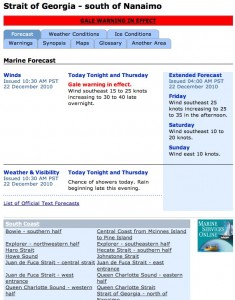We’ve been anchored out in the Kitsilano Anchorage for two weeks or so now, and we’re slowly getting used to the isolation again. Ever since we switched to a Zodiac inflatable dinghy with a 4hp Mariner outboard, I’ve grown somewhat lazy about rowing to shore, and since there’s nowhere to securely dock the Zodiac at Kits Beach, I’ve been finding reasons to avoid leaving the boat during the day. Honestly it’s not so bad, but the combination of rowing, dragging the rowboat up 150m of steep, wet sandy beach and cycling everywhere has me not particularly worried about that little extra layer of Christmas padding around my middle.

Just before getting the boot from False Creek by the VPD, we had a really interesting night of weather, resulting in a dragged anchor and a surprised crew. The night started off like any other cold, rainy December night, with strong winds from the east – Tie Fighter swung back and forth on her anchor line but held fast as expected. We anchored just off the tip of Charleston Park and settled into the forward cabin for a cozy night with a laptop full of movies and the diesel furnace blazing, but after about an hour of steady rainfall and increasing winds I thought it would be best to set an anchor-drag alarm on the GPS. Not twenty minutes later, the winds had continued to rise and the alarm went off, but we only dragged about ten meters to the west before setting firmly in place, ostensibly for the rest of the night.
About an hour later, things started to get weird. The rain pattering on the cabin roof became noticibly noisier, but then abruptly… stopped? Suddenly – in the span of maybe ten seconds – the wind died down to nothing, completely switched directions 180º, and started back up even stronger than before!
With the new westerly winds pushing her sideways, Tie Fighter swung around on her anchor rode and wandered to the east, uprooting her primary anchor again and resetting it pretty much immediately. I can only assume the new anchor setting wasn’t as strong as the prior, because within an hour the anchor-drag alarm was shrieking again and we were drifting east. To the credit of the CQR-and-Fortress anchor combo, we only drifted a few feet before coming to a stop.

Anyhow, since that night we’ve been sitting at anchor out in Kitsilano again, and we’ve endured a few nights of seriously heavy winds – though nearly all of those winds have been from the northeast through the southeast, we haven’t logged any winds at all from the west! That is all about to change of course; late tonight the forecast has us seeing 15-25kn of northwesterly winds.
The water out here in Kits is a lot more active, with winds throwing up small wave systems and the passing Granville water taxis sending regular wakes our way to the tune of about two foot waves. We bounce around a lot more – never enough to actually cause a cup of coffee to spill or anything like that, but enough that the flashlight hanging from the hook by the bed is slowly leaving a crescent-shaped black mark on the wall. It’s not much motion, but it’s constant. I quite like it, though I could certainly see how it could be a source of frustration for anyone not prepared for it.
Miya has held up admirably – we had worried that she’d have a hard time acclimatizing to the realities of living aboard a poorly-insulated sailboat in the winter, especially when she can be somewhat prone to motion sickness, but she has adapted extremely well. Barely two months aboard, and the other day at breakfast I had to point out to her that it was cold enough in the aft cabin that we could both see our breaths – neither of us had noticed the cold at all!

Moving forward, we have a few interesting project on the go, with a new diesel furnace for the aft cabin right up in the foreground. With any luck, all we need to do is acquire a bunch of diesel hoses and a small tank and the dampness problems we’ve been seeing in the aft cabin will be a thing of the past. The shift from the large diesel cookstove in the aft cabin was a great boon to our ability to cook – the convenience and familiarity of instant-on burners and the sheer unbridled decadence of freshly-baked bread have made living aboard in December a much, much more pleasant experience – but the reality of burning propane has begun to set in.
The problem with propane is that for every liter of propane burned, a liter of water is released into the air. Well, technically the gasses released by the combustion – one of which is apparently hydrogen – combine with the oxygen already present and create H20, which means a damp cabin. In essence, running the propane stove every day has meant that the moisture level in the aft cabin is far higher than in the forward cabin, and that is manifesting as foggy windows, slippery soap and chocolate, and worst of all the beginnings of mold and mildew. This really has to stop, but the only real answers are ventilation and dry heat!
Anyhow. Things progress. More soon.
So why did you get the boot from False Creek?
the usual; outstaying our welcome. in the winter months the bylaw says you can only be in there for three weeks at a time, then you have to spend three weeks out. we were in the creek for well over a month…
What an amazing accomplishment!
You’re poised for the best summer ever!
It’s funny, I know one guy fighting ties at sea, and one fighting ties on land. Neither of you can go through the drive through at fast food places.
-V